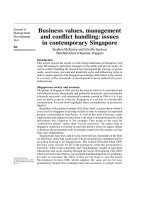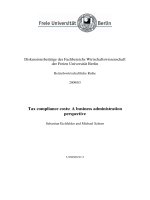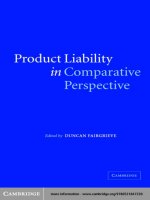PRODUCT LIABILITY IN COMPARATIVE PERSPECTIVE ppt
Bạn đang xem bản rút gọn của tài liệu. Xem và tải ngay bản đầy đủ của tài liệu tại đây (3.94 MB, 379 trang )
This page intentionally left blank
PRODUCT LIABILITY IN
COMPARATIVE PERSPECTIVE
This book examines the law of product liability from a comparative per-
spective. With the European Directive on Product Liability enacted over
twenty years ago, this publication analyses the state of product liability in
anumberofkeyjurisdictions including both Western European countries
and new Member States. Account is also taken of recent developments
further afield, including the United States and Japan. Distinguished con-
tributors, including a high court judge, European Commission official,
leading litigators and academics, provide individual country reports and a
number of integrated comparative studies. The book is designed for prac-
tical use by legal practitioners, academics, students and others interested
in the area of contract, tort, civil procedure and multi-party litigation. In
particular, practitioners will find the country reports an essential reference
point.
duncan fairgrieve is Director of the Tort Law Centre at the British
Institute of International and Comparative Law, and is also Ma
ˆ
ıtre de
Conf
´
erences at Sciences Po, Paris. He is a qualified French avocat and
practises in the fields of product liability and commercial litigation in
Paris.
PRODUCT LIABILITY IN
COMPARATIVE PERSPECTIVE
Edited by
DUNCAN FAIRGRIEVE
Cambridge, New York, Melbourne, Madrid, Cape Town, Singapore, São Paulo
Cambridge University Press
The Edinburgh Building, Cambridge ,UK
First published in print format
- ----
- ----
© Cambridge University Press 2005
Information on this title: www.cambrid
g
e.or
g
/9780521847230
This publication is in copyright. Subject to statutory exception and to the provision of
relevant collective licensing agreements, no reproduction of any part may take place
without the written permission of Cambridge University Press.
- ---
- ---
Cambridge University Press has no responsibility for the persistence or accuracy of s
for external or third-party internet websites referred to in this publication, and does not
guarantee that any content on such websites is, or will remain, accurate or appropriate.
Published in the United States of America by Cambridge University Press, New York
www.cambridge.org
hardback
eBook (EBL)
eBook (EBL)
hardback
CONTENTS
List of figures page vii
Foreword by Sir Michael Burton ix
List of contributors x
Preface xiii
1Introduction 1
Duncan Fairgrieve and Luis Gonz´alez Vaqu´e
part i Country reports
2Theuse of comparative law in A&Others v National Blood
Authority 13
Michael Brooke and Ian Forrester, Postscript by Nicholas
Underhill, Afterword by Sir Michael Burton
3Spanish product liability today – adapting to the
‘new’ rules 42
Miquel Mart´ın-Casals
4Interaction between the European Directive onProduct
Liability and the former liability regime in Italy 67
Eleonora Rajneri
5 L’Exception fran¸caise? The French law of product
liability 84
Duncan Fairgrieve
6German product liability law: between European Directives,
American Restatements and common sense 100
Stefan Lenze
7Dutch case law on the EU Product Liability Directive 126
Cees C. van Dam
v
vi contents
8Defect in English law – lessons for the harmonisation of
European product liability 138
Geraint Howells
part ii European influences
9Productliability: basic problems in a comparative law
perspective 155
Hans Claudius Taschner
10 The development risks defence 167
Mark Mildred
11 Approaches to product liability in the EU and Member
States 192
Christopher Hodges
12 Product liability – a history of harmonisation 202
Geraint Howells
part iii Comparing systems
13 Harmonisation or divergence? A comparison of French and
English product liability rules 221
Simon Taylor
14 Product liability law in Central Europe and the true impact of
the Product Liability Directive 244
Magdalena Sengayen
15 Bugs in Anglo-American products liability 295
Jane Stapleton
16 Comparing product safety and liability law in Japan: from
Minamata to mad cows – and Mitsubishi 334
Luke Nottage
Appendix 341
Index 350
FIGURES
16.1 Comparative PL law trajectories page 337
16.2 PL litigation in Japan over the 1990s 338
vii
FOREWORD
This is an extraordinary book, in which I am honoured to be included,
and which I am even more privileged to be able to introduce. It contains
contributions from an array of the leading thinkers in the field of product
liability; and it provides substantial food (non-standard, and certainly not
defective) for thought for practitioners, academics and students alike. The
British Institute of International and Comparative Law has been in the
forefront of debate in the field of product liability, organising conferences
from which no self-respecting practitioner or academic in the area could
afford to be absent, and now, after ‘rounding-up all the usual suspects’,
producing this totally riveting book.
As the judge in the Hepatitis C litigation, I had the opportunity of
climbing a steep learning curve, supervised by Counsel, but educated by
leading academics not only from the United Kingdom, but from Europe
and of course Australia. Now they are all collected together in one place.
They may not agree (either with each other, or – even! – with the Hepatitis
Cjudgment) but, taken together, their views constitute the corpus of
present thinking, and it makes a stimulating and enlightening read.
sir michael burton
ix
CONTRIBUTORS
his honour judge michael brooke QC.
mr justice burton,HighCourtJudge; President of the Employment
Appeal Tribunal; Chairman of the Central Arbitration Committee.
professor dr cees c. van dam,Professorial Fellow in European Tort
Law and Director of the Regulation Forum, British Institute of Interna-
tional and Comparative Law.
dr duncan fairgrieve,Fellow,British Institute of International and
Comparative Law; Maˆıtre de Conf´erences, L’Institut d’Etudes Politiques
de Paris; Avocat
`
alaCour,Paris.
ian forrester QC, White and Case LLP.
luis gonz
´
alez vaqu
´
e,Advisor, DG MARKT, European Commission.
christopher hodges,Partner,CMS Cameron McKenna.
professor geraint howells,Professor of Law, Lancaster University
and Barrister, Gough Square Chambers.
stefan lenze,Visiting Fellow, the British Institute of International and
Comparative Law.
professor miquel mart
´
ın-casals,Professor of Civil Law, Obser-
vatory of European and Comparative Private Law, University of Girona
(Spain).
professor mark mildred,Professor of Litigation, Nottingham Trent
University.
dr luke nottage,Senior Lecturer, University of Sydney Law Faculty.
dr eleonora rajneri,Researcher in Private Law at the Faculty of
Economics of the Universit
`
adelPiemonte Orientale.
x
list of contributors xi
dr magdalena sengayen,Research Officer in Product Liability and
Regulatory Issues, Centre for Socio-Legal Studies, Oxford University.
professor jane stapleton,Research Professor, Australian National
University; Ernest E. Smith Professor of Law, University of Texas; Com-
monwealth Fellow, British Institute of International and Comparative
Law.
professor dr hans claudius taschner,Former Head of Unit,
European Commission.
dr simon taylor, Maˆıtre de Conf´erences,Universit
´
eParis7Denis
Diderot.
nicholas underhill QC, Fountain Court Chambers.
PREFACE
The aim of this book is to examine the law of product liability from a
comparative law standpoint. It is now ten years since the publication of
Comparative Product Liability,edited by Professor C. J. Miller and pub-
lished by the British Institute of International and Comparative Law in
association with the United Kingdom National Committee for Compar-
ative Law. The time was thus ripe to examine the topic again.
The origin of this book is a research project undertaken by the Tort
Law Centre at the British Institute of International and Comparative Law.
Many of the contributions to the book have emerged from the Institute’s
work on product liability, whilst other chapters were originally presented
by their authors at Institute events.
It is also appropriate to mention here the role of the Product Liability
Forum, which, as well as generously supporting the work of the Institute
in this area, has provided a stimulating arena for discussion of product
liability issues.
Many thanks also to the staff of Cambridge University Press who have
overseen the production process.
The Law is as stated on 1 March 2004.
duncan fairgrieve
xiii
1
Introduction
duncan fairgrieve and luis gonz
´
alez vaqu
´
e
Product liability and overlapping interests
The essence of product liability is the apportionment of the risks inher-
ent in the modern mass production of consumer goods. A choice must
be made as to who should bear these risks: the victim, the state or the
manufacturer?
Despite this apparent simplicity, the law of product liability is indeed a
complex one,lying asitdoeson theoverlap ofaseries ofdifferent matrices.
In terms of substantive law, the law of contract and the law of tort make
up one layer of rules, with oft-conflicting concepts and approaches. To
this, a supranational stratum has been added. The European Directive on
Product Liability has brought an important dimension of European Com-
munity law,
1
with the introduction of terms often alien to the national
systems, such as ‘putting into circulation’ or ‘defect’, as well as the techni-
cal debates over competence and levels of harmonisation brought about
by the European legislation. The law of product liability is further com-
plexified due to the superposition of a myriad of other domestic rules
stemming from the broader legal framework of consumer law, proce-
dures governing damages claims, and, in some scenarios, the application
of notions of public law.
2
This complex legal framework must also be set within the broader
policy debate. The framing of product liability regulation has been
underpinned by a stark debate with conflicting viewpoints, on occasion
Anyopinions expressed in this piece or mistakes made are those of the authors personally,
and do not represent the views of the Commission.
1
Council Directive of 25 July 1985 on the approximation of the laws, regulations and
administrative provisions of the Member States concerning liability for defective prod-
ucts (85/374/EEC), OJL 210.
2
See e.g. Conseil d’Etat, 3 March 2004 (State liability for failure to take preventive measures
to reduce risks of work-related asbestos exposure). The text of this judgment and analysis of
the decision may be found on the BIICL Product Liability Database, which may be accessed
at www.biicl.org.
1
2duncan fairgrieve and luis gonz
´
alez vaqu
´
e
characterised as a struggle of consumer versus industry. Avoiding such
oversimplification, account must nonetheless be taken of the important
macro debate about how the varied interests of the victim, the producer,
the insurer, the distributor et al., should be correctly accommodated
within the architecture of product liability regulation. At the core of any
system forcivil liability is the concern for thecorrect provision of compen-
sation. There is however a recognition that in framing the law in this area,
account must be taken of broader considerations, including the availabil-
ity of alternative means of financial support such as insurance payments
and social security awards, broader societal concerns about the function
of the tort system, as well as the rights of the defendants, a consideration
referred to in the contribution by Christopher Hodges as ‘commercial
continuity’.
3
The European Directive and harmonisation
The factors which led to the intervention of the European legislator in
this area of the law are significant.
4
Under a broad consumer-protection
agenda, the Commission’s attention settled on civil liability, with reform
of the European-wide product liability at the forefront. Underpinning
the development of the Directive were the parallel but distinct con-
cernsof, on the one hand, the US-influenced review of commercial
sale and supply of goods, and, on the other, the potent impact of the
European-wide thalidomide drug tragedy in the 1960s and the inadequate
response oftraditionalcontract (warranty) andtort law totheplight of the
victims.
5
Afterprotracted negotiations at a supranational level, partly due to the
conflicting policy considerations described above, the European Product
Liability Directive was eventually adopted.
6
The Directive was introduced
as an internal market measure under Article 100 of the Treaty, which con-
cernsthe harmonisation of laws directly affecting the establishment of
the common market. Nonetheless, there has been a good deal of debate
whether the measure should correctly be perceived as an internal market
or rather as a consumer protection initiative. In the contributions to this
3
See chapter 11.
4
Generally, see J. Stapleton, Product Liability (London: Butterworths, 1994) chapter 3.
5
Ibid.
6
Council Directive of 25 July 1985 on the approximation of the laws, regulations and
administrative provisions of the Member States concerning liability for defective prod-
ucts (85/374/EEC), OJL 210.
introduction 3
book, we shall see that the European Court of Justice seems to have pre-
ferred the internal market argument. As a result, it has been decided that
the Directive was intended to effect a ‘complete’ and not ‘minimum’ har-
monisation.
7
As aconsequence, Member States cannot increase consumer
protection other than in areas where this was provided for expressly by
the Directive.
Aseriesofobstaclestothis goal of maximum harmonisation remain. As
aconsequence of political compromises, Member States were presented
with a menu of options and add-ons under the Directive, covering the
development risks defence, the exclusion of primary agricultural produce
and game
8
and a ceiling on personal injury damages. Moreover, many of
the concepts in the Directive are left undefined, such as the crucial notion
of ‘putting into circulation’.
9
Even where a definition is given, the margin
for manoeuvre in interpretation can be large.
10
Thus the core notion of
‘defect’ ofaproductisdefinedaswhenaproduct does not ‘provide the
safety which a person is entitled to expect’.
11
Crucially, under the Directive, various key elements of a product liabil-
ity action are simply left to domestic law, including areas as fundamental
as causation, remoteness of damage, standard of proof, contributory acts,
assessment of damages, procedure and rules of discovery. Over and above
these areas specificallyleftoutwith theDirective,Article 13 oftheDirective
leaves open the possibility of a co-existence of product liability systems.
We shall see that these parallel systems play an important role in countries
such as France (where the innovative Cour de Cassation case law on no-
fault liability can be considered markedly pro-claimant),
12
and Germany
(where the thalidomide tragedy resulted in a statutory no-fault regime for
liability in pharmaceutical cases).
13
7
See Case C-183/00 Gonzalez Sanchez v Medicina Asturiana SA [2002] ECR I–3901; Case
C-52/00 Commission v France [2002] ECR I-3827.
8
Subsequently amended: Directive 99/34 OJ 1999 L 141/20.
9
See Articles 6, 7and 11 of the Directive. Under the French provisions, a further gloss isthus
givenonthe notion of ‘put into circulation’, as follows: ‘A product is put into circulation
when the producer has voluntarily parted with it. A product is put into circulation only
once’ (Article 1386–5 of the Civil Code).
10
Note also that linguistic variations have themselves engendered further divergences. The
differing interpretation of the Article 9(b) exclusion of the first 500 euros of property
damage between a lower-limit cut-off point oranon-claimable insurance-style ‘excess’
are examined in the contributions to this book.
11
See Article 6 of the Directive.
12
See chapter 5 on product liability in France.
13
See chapter 6 on product liability in Germany.
4duncan fairgrieve and luis gonz
´
alez vaqu
´
e
Clearly, given these potential divergences, it is crucial to compare and
contrast the national courts’ stances in order to assess the success of the
objective of unification. We turn thus to the role of comparative law.
Product liability: why compare?
Comparative law is increasingly recognised as an essential reference point
for judicial decision-making. Whilst the English courts have long been
open to considering how legal problems are solved in other jurisdictions,
and in tort cases the courts haveeven showed an interest in looking further
afield than common law jurisdictions,
14
the recent case of Fairchild v
Glenhaven Funeral Services Ltd has further reinforced this trend. In his
judgment, Lord Bingham conducted a comparative law survey on a point
of causation and declared that:
Development of the law in this country cannot ofcoursedependona
head-count of decisions and codes adopted in other countries around the
world, often against a background of different rules and traditions. The law
must be developed coherently, in accordance with principle, so as to serve,
even-handedly, the ends of justice. If, however, a decision is given in this
country which offends one’s basic sense of justice, and if consideration of
international sources suggests thata different and more acceptable decision
would begiveninmostotherjurisdictions, whatever their legal tradition,
this must prompt anxious review of the decision in question. In a shrinking
world theremustbesomevirtueinuniformityofoutcomewhatever
the diversity of approach in reaching that outcome.
15
The growing use of comparative law poses a challenge to judges and
counsel. It is recognised that scholarship also has an important role to play
in making comparative material available in asystematic manner. The role
of comparative law in the judicial process is subject to increasing scrutiny,
covering topics as diverse as the relevance and weight of comparative law
arguments, to the practical aspects of how to present those arguments to
acourt or the accessibility of source materials.
16
14
See e.g. McFarlane v Tayside Health Board [2000] 2 AC 59, 73 and 80–1; Henderson v
MerrettSyndicates [1995] 2 AC 145, 184; White v Jones [1995] 2 AC 207, 263.
15
[2002] UKHL 22, para 32. Lord Rodgers also observed that ‘[t]he Commonwealth cases
weresupplemented, at yourLordships’ suggestion, bya certain amountofmaterial describ-
ing the position in European legal systems . . . The material provides a check, from outside
the common law world, that the problem identified in these appeals is genuine and is one
that requires to be remedied’ (para 165).
16
See generally Guy Canivet, Mads Andenas and Duncan Fairgrieve, Comparative Law before
the Courts (London: BIICL, 2004).
introduction 5
Comparative law has a particularly important role to play in the devel-
opment of European Community law. For, unless there is an exchange of
judgments of national courts on the application of Community law, then
anygoal of harmonisation becomes illusory. Harmonisation cannot solely
be achieved simply through legislative initiative. It must also be fostered
by means of debate between the legal communities of the Member States,
and an exchange of the decisions applying and interpreting that primary
legislation.
This comes to the fore in the application of the Product Liability Direc-
tive. The potential role for comparative law, as well as the challenges that
it poses, are well illustrated in the seminal product liability case of Av
National Blood Authority,
17
in which Mr Justice Burton drew extensively
upon comparative law as a core aspect of his decision-making.
18
His Lord-
ship opined that:
Ihavehadthegreatbenefit of detailed submissions in writing, and some
ten daysofexegesisand argument orally in opening and closing by leading
counsel, just on the law, including authorities and academic writings from
France, Germany, Spain, Portugal, Sweden, Denmark, Belgium, Italy, Hol-
land, Australia and the United States, as well as the United Kingdom and
the European Court.
It is thus clear that the harmonisation effort does not end with the mere
implementation of the Product Liability Directive. The success of the
enterprise is likely to depend upon the harmonised interpretation of
the provisions by the national courts. It is hoped that in some way this
publication, as well as the Product Liability Database developed by the
British Institute,
19
will participate in this laudable endeavour of achieving
‘a higher and consistent level of consumer protection throughout the
Community’.
Contents of the book
There have been a number of learned publications examining European
product liability in comparative perspective.
20
Any comparative study of
17
[2001] 3 All ER 289; [2001] Lloyd’s Rep Med 187.
18
Fordetailed discussion, see chapter 2.
19
Formore details of the BIICL Product Liability Database, see www.biicl.org.
20
See e.g. P. Kelly and R. Altree (eds.), European Product Liability (London: Butterworths,
1992); G. Howells, Comparative Product Liability (Dartmouth: Ashgate, 1993); A. Geddes,
Product and Service Liability in the EEC (London: Sweet and Maxwell, 1992); D. Campbell
and C. Campbell (eds.), International Product Liability (London: LLP, 1993); C. Hodges
(ed.), Product Liability: European Laws and Practice (London: Sweet and Maxwell, 1993).
6duncan fairgrieve and luis gonz
´
alez vaqu
´
e
product liability can at best give a snapshot of the law at a given time, as
the legal provisions and decisions constantly develop. However, the time
is clearly ripe for a re-evaluation of the present state of the law through
an examination of the reception of the European Directive in a number
of European countries, both long-standing Member States as well as New
Member countries.
The contributions to the book are divided between a series of discrete
reports onthestate ofproductliability inindividual countries, and contri-
butions which examine the issues from a horizontal approach, analysing
developments from a European perspective or presenting and comparing
approaches in different legal systems or across a region.
In the first part of the book, ‘Country reports’, accounts are given of the
legislation and case law on product liability in individual countries. Much
of this analysis is concerned with the way in which the European norm has
beenintegratedintothenationallegalsystems,raisingissues governingthe
reception ofanexternallegalnotion into a pre-existing national system.
The reception of the Directive is illustrated in a representative series of
Member States, encompassing both common law and civil law countries,
including England, France, Italy, and Spain. Commencing with a rich
comparative law analysis by the protagonists (counsel and judge) in the
English case of AvNational Blood Authority,
21
undoubtedly the leading
judicial analysis of product liability provisions in any of the Member
States,
22
contributions then follow covering developments in Continental
systems.
Anumberofcommonthemes can be identified in the contributions in
this section. First, and unsurprisingly, the theme of harmonisation under-
pins manyof thecontributions. Theauthorsthus undertake anassessment
of the way in which the national systems have received the new European
norm, the way in which the substantive law has been transformed, and
how far the process of harmonisation has been achieved.
Second, and linked to the first, the contributions highlight the growing
importance in the Member States of the taking into account of solu-
tions adopted in other systems. A cross-fertilisation of judicial solutions
is recognised as increasingly important. This is most strikingly evident in
the aforementioned English case of AvNational Blood Authority.
23
Over
and above this, Professor Cees van Dam explains how the Dutch Supreme
Court DES case has attracted international interest.
24
Nonetheless, it is
21
[2001] 3 All ER 289; [2001] Lloyd’s Rep Med 187.
22
Fordetailed analysis of this case, see chapter 2.
23
[2001] 3 All ER 289; [2001] Lloyd’s Rep Med 187.
24
See chapter 7.
introduction 7
clear that much remains to be done to enhance this comparative law
exchange. The methodology for facilitating and encouraging this process
is a point that is developed in other contributions.
25
Third, and in contrast with these initial themes, it is important to note
that in thevarious Member States,thereisevidence of acontinuingvitality
of the parallel regimes of liability.Thisis partly due to substantive reasons,
where the pre-existing systems in some respects offer more favourable
solutions (see for instance Italy and France),
26
and partly due to inertia
created by lack of familiarity with the new regime.
Fourth, it is clear from the contributions that difficulties of interpre-
tation continue to prevail. This is well-illustrated in the detailed analysis
of Professor Mart
´
ın-Casals,
27
who analyses the Spanish cases with a fine-
tooth comb, and observes that whilst the court decisions show that the
judges are grappling with the issues, there has nonetheless been a number
of judgments which are ambiguous or equivocal on crucial issues under
the Directive. The European judiciary are thus undergoing a compulsory
education in the thinking underpinning the Directive, in respect of which
the learning curve is steep!
28
Fifth, onasimilar theme, manyofthecontributions highlight therecur-
ring theme of the problem of access to justice, which is left outside the
scope of the Directive. The small number of cases under the Directive
across Europe is attributed in part by Dr Rajneri in her paper on Italy to
the difficulty,
29
as contrasted with the US, in funding the development of
products claims. This concern underlines the importance of the procedu-
ralenvironment on the successful assertion of substantive rights, a factor
which has been highlighted by studies undertaken into the operation of
the Directive.
30
In the final contribution in this section, Professor Howells traces the
English case law on the notion of defect.
31
Beyond the substantive law,
his contribution examines the way in which the English product liability
decisions make a case study for the development of European private law.
This piece thus provides a bridge between the country report section and
the further contributions, which take a more lateral perspective.
25
See in particular chapter 8,‘Defect in English law – lessons for the harmonisation of
European product liability’ by Professor Geraint Howells.
26
Respectively chapters 4 and 5.
27
See chapter 3.
28
See the words ofMrJusticeBurtonintheForewordtothisbook.
29
See chapter 4.
30
See Lovells, Product Liability in the European Union: areport for the European Commission,
February 2003,Markt/2001/11/D.
31
See chapter 8.
8duncan fairgrieve and luis gonz
´
alez vaqu
´
e
Moving beyond the country-based analyses, Part II,‘European influ-
ences’, adopts a horizontal approach to the topic, analysing the way in
which the concepts in the European norm have been applied and devel-
oped across the Member States.
Professor Dr Hans Claudius Taschner provides an authoritative open-
ing to this part.
32
As the person most closely associated with the genesis
and drafting of the Directive, he expands his views on the current state
of the harmonisation process in uncompromising fashion. He highlights
three recurrent themes: the debate over the standard of liability arising
from the Directive, the ceiling on the amount of damages and the vexed
question of the development risks defence.
The issue of the development risks defence is then taken up in some
detail by Mark Mildred, combining the viewpoint of a practitioner and
academic.
33
This is a timely contribution at a point where the very exis-
tence ofthedefence is currently under review by the European Commis-
sion, and an important report into the economic effects of the defence
has been undertaken.
34
In his paper, Christopher Hodges points out that the picture across
Europe in relation to the substantive law on liability contains a num-
ber of variations and that certain decisions fragment the appearance
of harmonisation.
35
This complex situation is accentuated by diver-
gences in the areas of access to justice, litigation procedure and levels of
compensation.
As aconclusion to this part, Professor Howells analyses the harmonisa-
tion debate from a supranational and Member State perspective.
36
Using
the central concepts of defect and the development risks defence to show
that constructive steps need to be taken to clarify key elements of the
Directive in order to facilitate the harmonisation process, Professor How-
ells makes the important point that harmonisation can only be advanced
if cross-border dialogues are encouraged and enhanced. He thus makes
32
See chapter 9.
33
See chapter 10.
34
The Report of the Fondazione Roselli was submitted in June 2004. The overriding con-
clusion of the Report was that the economic impact of removing the development risks
defence would be significant and therefore the defence should not be removed. In the
report, it is argued that the removal of the development risks defence from the Direc-
tive would lead to a decrease in product variety, radical innovation by producers and
basic research into new products. Insurance costs would also rise and in some cases risks
would become uninsurable. The report recommends however that the Commission create
acompensation fund at an EU level as a means for guaranteeing protection from product
development risks.
35
See chapter 11.
36
See chapter 12.
introduction 9
apowerful plea for the creation of common communication structures,
such as the development of case law databases.
37
Part III,‘Comparing systems’, brings together a series of papers com-
paring products legislation and cases across a number of different juris-
dictions.
Simon Taylor analyses two very different legal systems, England and
France.
38
Taking these countries as representatives of the civil law and
common law legal families, Dr Taylor’s analysis is a case study in the effect
of the harmonising goal of the Directive. Dr Taylor notes that despite
the objective of maximal harmonisation, there still appears to be con-
siderable divergence in both systems, due in large part to the continuing
co-existence of, and, in France, the preference for, pre-existing parallel
liability systems.
The European theme is continued in the contribution of Magdalena
Sengayen which touches upon a topic largely unexplored in Western aca-
demic writing, that of the product liability laws in Central Europe, namely
Poland, the Czech Republic and Hungary.
39
This is a crucial subject both
in practical terms, due to the developing economic importance of the
NewMember economies, and in conceptual terms, due to the impact of
enlargement on the broader harmonisation process. Dr Sengayen devel-
ops the argument that while the substantive provisions of the Directive
are not likely to cause an upheaval in Central Europe as product liability
provisions have never been considerably different from those in Western
Europe,the surrounding context of institutional and procedural basis of
the Central European product liability regimes is indeed undergoing a
profound transformation.
In the two final chapters of this book, the focus of analysis shifts beyond
Europe to analyse developments further afield. Professor Jane Stapleton,
the leading authority on product liability, examines and compares devel-
opments within the US and Europe, taking as a focus the increasingly
controversial topic of pathogenically infected products, such as bacterial
and viral infection of products, and diseases such as Creutzfeldt-Jakob
Disease (CJD).
40
Dr Luke Nottage examines the impact of the principles
underpinning the European Directive in Japan.
41
Forease of use, the text of the European Directive on Product Liability
is included in an Appendix to this book.
37
See footnote 19 above.
38
See chapter 13.
39
See chapter 14.
40
See chapter 15.
41
See chapter 16.









